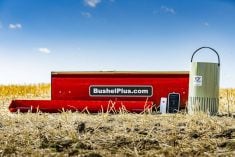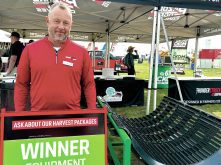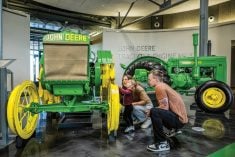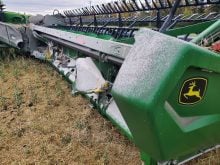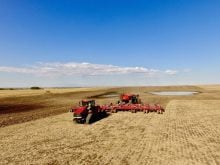By the time this issue arrives in your mailbox, harvest should be well underway. In parts of the Palliser Triangle, the meagre harvest may be all over. Thankfully, many areas in 2022 will be a much different story than the huge drought of 2021. Some areas were too wet and needed heat to advance the crop but some areas will harvest good crops.
As I reflect on my combining days, I had 63 continuous years where it was my pleasure to rub out at least a few loads.
In the beginning
Read Also

Claas brings 1000 Series SP forage harvesters to Canada
In mid-August, Claas unveiled its new line of Jaguar forage harvesters at an event in Visalia, California, deep in the heart of that state’s dairy region.
The beginning for me was age 15 on Brunswick Farm at Milden, Sask., where I was raised. The combine was an Oliver 30 pull-type combine powered by a six-cylinder Continental gas engine. My Dad suffered cataracts from age 10 and his eyesight was limiting for combine operation, so each fall he hired a combine man. At age 15, he decided I should be up for the task. He hired an experienced man to take a half day to show me the ropes — and off I went.
The old Oliver was pulled by a Massey-Harris 55 tractor with hydraulics for the table lift. Lights for night combining were the one tractor fender light directed to the combine and a six-volt, 100-watt bulb that was hung from the operator’s platform. The combine was really designed for straight cutting with the grain laid on the canvas and fed evenly into the cross conveyor directed to the 18-inch cylinder. However, swathing was the current practice and the pickup was a drum pickup with steel teeth.
Fortunately, we had level clay land with few stones, but late one night there was a huge bang — and all went silent. A stone had gone straight into the cylinder and killed the combine motor, so all was eerily silent — and I was a very scared 15-year-old. You grew up fast under fire. A flashlight inspection showed there were three bent rub bars. In the morning, the rub bars were removed, taken to town to get straightened and put back in.
The final combine on Brunswick Farm was a used, self-propelled Cockshutt 132. On the very first field the feeder chain packed it in, and I learned how to replace it by doing. For the most part, I have good memories with that machine.
In 1963, Brunswick Farm was purchased by my eldest sister and family. It was my pleasure to operate a Massey-Ferguson 510, complete with factory cab on the home quarter. My nephew was on a second 510 in the same field. It was a hot August day and we ended up in our shorts and hanging out the door when the wind was right. The engine was right next to the cab, so the heat load was unbearable. Companies soon learned that a cab had to be accompanied by air conditioning.
Near Saskatoon and university days
Keith Ayres, my good friend and colleague on the soil survey, was from a farm near Saskatoon. For many years, I ran Massey-Harris 90 combines at that place. They were a serious combine for the day with many happy memories. The downside was years when combining stretched into November. We wrapped a canvas over the front of the operator’s platform and piled on layers of clothes. By the end of the day, we were so cold it was hard to crawl off the combine. For some reason, the old 90s liked the cold because they seemed to keep running with no breakdowns.

Keith then acquired two used MF 750 combines complete with cabs and air conditioning. They were sweet machines and could really do the work. Forever etched in my mind is an evening at 9 p.m. when we pulled into a 60-acre field of 40-bushel wheat. The combines never stopped until the field was done at midnight, and Keith had 2,400 bushels piled on the ground at the edge of the field. A fun time. The beauty of the harvest.
Combining in Tanzania
From 1972-74, I was part of the Tanzania-Canada Wheat Project — the objective was to transfer Canadian Prairie dryland wheat practices to northern Tanzania. We were headquartered on a former British Coffee Research Station on the southern slopes of famous Mount Kilimanjaro. Fields on the coffee station were too small for Canadian equipment, so we partnered with a nearby sisal plantation. Sisal markets were shrinking, and wheat was an alternative crop.
We were sent a German John Deere 630 combine with a pickup designed for 60-bushel crops. It did not pick up 20-bushel crops that well.
That combine also had a fourrow corn header. It was my pleasure to rub out a few hoppers of corn. I never saw a grain tank fill as fast as it did in corn. Local folks were hired to pick up and pile fallen cobs. The combine was set running next to the pile of cobs, which were tossed in. The hopper filled in no time that way.

Modern era combines
Combines of the last decade have continuously improved to where they are grand machines with operator comfort like sitting in the living room.
The first combine with a real tight door and quiet cab was the Case IH 2188/2388.
It was my pleasure to spend a day or two on a series of MF combines on my son-in-law’s farm at Annaheim, Sask. — the heart of the sure crop district. The Thick Black soil with a foot or more of topsoil and a water table in play most years churns out big crops. A real big lesson was learned in 2011, which was the best year ever. The MF 9560 could easily churn through the huge canola swaths without even grunting hard. Lots of threshing capacity. However, in a 70-bushel crop it could not separate the canola from the straw/chaff, etc.
The only way to get all of the canola was to travel at 1.6 m.p.h. I did my own little experiment to prove we got 70 bushels per acre at 1.6 m.p.h., but only 55 bushels per acre at full threshing capacity at approximately three m.p.h. I am still convinced there is enough canola left in many fields to pay for the inputs. Many think, “What’s not to like about a 55-bushel canola crop,” but if you are leaving 15 bushels in the field, there is lots not to like.

Combines at my Dundurn farm
At Dundurn, the modern combines I ran were a John Deere 9770 and S680. The John Deere also needed to go slow in big canola swaths to get it all in the hopper. Combining was proceeding on my crop at three to four m.p.h. I ran the combine at suppertime and soon learned that two m.p.h. was required to provide separating capacity. Combining proceeded at that speed and a good yield was binned.
On many Saskatchewan farms, big canola crops requiring lower speeds will not be an issue in the 2022 harvest. Here’s to a safe harvest and to better things next year.




